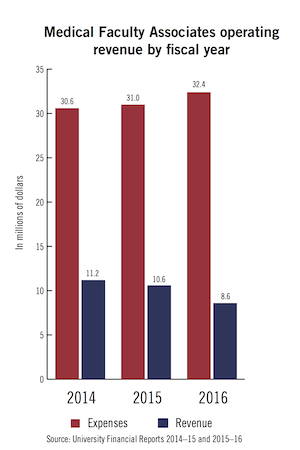The GW-affiliated organization that houses 750 medical professionals in the D.C. area has received a $20 million line of credit from the University.
Medical Faculty Associates, an independent physician group whose professionals are faculty in the School of Medicine and Health Sciences and has an academic partnership with the University and GW Hospital, will receive a $20 million line of credit from the University after spending three times their revenue for the past two fiscal years, according to the University’s annual financial report. Financial experts said the new line of credit could mean that the group is planning to expand.
For the past two fiscal years, MFA’s expenses have totaled about three times the amount of their revenues – both years the organization brought in about $10 million and spent more than $30 million. The MFA is its own nonprofit organization that split from the University in 2000 but holds an Academic Affiliation Agreement with GW where they provide clinical teaching, research and administrative services to the University.
University spokeswoman Maralee Csellar said the MFA and GW are working with each other to grow their “clinical enterprise” to better support their academic mission.
“A strategic plan is being developed to ensure the long-term success of our clinical enterprise in the rapidly changing health care marketplace in the Washington metropolitan area,” Csellar said.
Csellar declined to comment on the conditions and limitations of the MFA’s line of credit, the specific purpose of the loan and whether the University has given loans like this to affiliated organizations in the past.
Susan Tulino, the director of communications and marketing at the MFA, declined to comment, deferring to Csellar’s response.
Tulino declined to comment on what made up MFA’s expenses for the past two years and whether there were noticeable causes for the increase, what steps the MFA is taking to address it, if they plan to change the MFA financial strategy of the MFA in the future, what specifically the line of credit is for and whether or not this is the first time they have received a line of credit from GW.
The University lent an unsecured line of credit for $20 million to MFA, with an immediate initial draw of $5 million at an interest rate of 6 percent. The loan will last until January 2026.
The MFA’s operating revenue remained about the same in fiscal year 2014, with a revenue of $11.2 million and expenses of $30.6 million, according to financial documents.
Ryan Williams, an assistant professor of finance at the University of Arizona, said the low operating revenue and new line of credit could indicate that the MFA is growing: When companies are expanding, they often have high expenses and low returns.
As long as those return patterns don’t continue for more than three to five years, the finances should be stable, he said.
“If they need funding for expansion, to build new offices or new medical facilities, then you would see debt go up, which is the credit line,” he said. “You would see expenses go up, but you may not see revenue catch up for another few years.”
Williams said the MFA likely went to the University instead of an outside bank for a line of credit because they could get a better interest rate from an organization that is familiar with the group’s finances and creditworthiness. The 6 percent interest rate falls in line with similar market rates, he added.
“Your mom is going to charge you a lower interest rate than American Express would,” Williams said.
In 2011, the MFA was planning to double the number of doctors at the practice by adding 450 doctors to expand its services throughout the District. Last year, there were 61 open faculty positions for the School of Medicine and Health Sciences and the MFA posted on GW’s jobs website.
Kevin Grant, an accountant for Tulane University’s medical department, said there are several reasons why revenue would be so low compared to the expenses, including high faculty salaries, the association not billing enough, not billing correctly or not seeing enough patients.
The average salary of a SMHS faculty member is $146,400, according to the most recent number from the Office of Institutional Research from 2011.
Medicare and the U.S. government recently decreased payment rates for medical care, which means hospitals are making less money while doctors’ salaries remain high, Grant said.
“It’s all about finding revenue. So there’s the billing aspect of it, seeing patients — that aspect of it.” Grant said. “But then there’s also a lot of universities that are going out and doing contract work.”





